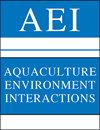野生、养殖和杂交大西洋大马哈鱼在自然界的相对生存和健康相关性状的普通花园比较
IF 2.5
2区 农林科学
Q2 FISHERIES
引用次数: 2
摘要
当人工养殖的大西洋大马哈鱼与野生鱼类杂交时,不适应基因的渗入会降低野生种群的生产力,并改变关键的生活史特征。迄今为止,只有少数欧洲研究比较了野生、养殖和杂交鲑鱼在野外的共同条件下,分离出基因对生存和健康相关特征的影响。在这里,我们在纽芬兰南部的3个地点研究了4种杂交类型(野生、养殖和互惠f1杂交)的大西洋鲑鱼鱼苗在生长的第一个夏天的表现。总体存活率高,不同地点的杂交类型排序一致(平均捕获率:野生母杂交26.2%≈野生26.0%,>农场19.2%,>农场-母亲杂交12.8%)。野生鱼比野生母杂交种和农场鱼小,尽管与农场母杂交种的大小差异较小。在3个地点中的2个,野生母杂交鱼比野生和农场母杂交鱼大,但只比农场鱼有很小的尺寸优势。形状差异很小,主要与身体深度有关,野生鱼和养殖鱼之间的差异最大。在同一地点,野生母杂交品种的配对标记比其他杂交品种的配对标记少,尽管标记大小的差异很小,但养殖鱼的标记往往最窄。总体而言,这些结果表明,即使在较短的时间尺度和有利的环境条件下,野生、农场和杂交幼鱼之间的适应性相关性状存在遗传差异,并可能导致野生农场-母亲杂交和野生农场生存减少的模式。本文章由计算机程序翻译,如有差异,请以英文原文为准。
Common-garden comparison of relative survival and fitness-related traits of wild, farm, and hybrid Atlantic salmon Salmo salar parr in nature
: When escapee farmed Atlantic salmon Salmo salar interbreed with wild fish, the introgression of maladaptive genes can lower wild population productivity and alter key life his-tory traits. To date, only a few European studies have compared wild, farm, and hybrid salmon under common conditions in the wild, isolating the influence of genetics on survival and fitness-related traits. Here, we examined the performance of experimentally derived Atlantic salmon fry from 4 cross types (wild, farm, and reciprocal F 1 hybrids) during the first summer of growth at 3 locations in southern Newfoundland. Overall survival was high, with the cross type rank order consistent across sites (mean percent recaptured: wild-mother hybrids 26.2% ≈ wild 26.0% > farm 19.2% > farm-mother hybrids 12.8%). Wild fish were smaller than wild-mother hybrids and farm fish, though differed less in size from farm-mother hybrids. At 2 out of 3 sites, wild-mother hybrids were larger than wild and farm-mother hybrid fish but had only a small size advantage over farm fish. Shape differences were small and mainly related to body depth, with the largest differences between wild and farm fish. Wild-mother hybrids had fewer parr marks than other cross types at a single site, and though differences in the size of marks were minimal, farm fish tended to have the narrowest marks. Overall, these results show that genetic differences exist for fitness-related traits among wild, farm, and hybrid juveniles, even over short temporal scales and under favourable environmental conditions, and may contribute to patterns of reduced farm-mother hybrid and feral farm survival in the wild.
求助全文
通过发布文献求助,成功后即可免费获取论文全文。
去求助
来源期刊

Aquaculture Environment Interactions
FISHERIES-MARINE & FRESHWATER BIOLOGY
CiteScore
4.90
自引率
13.60%
发文量
15
审稿时长
>12 weeks
期刊介绍:
AEI presents rigorously refereed and carefully selected Research Articles, Reviews and Notes, as well as Comments/Reply Comments (for details see MEPS 228:1), Theme Sections and Opinion Pieces. For details consult the Guidelines for Authors. Papers may be concerned with interactions between aquaculture and the environment from local to ecosystem scales, at all levels of organisation and investigation. Areas covered include:
-Pollution and nutrient inputs; bio-accumulation and impacts of chemical compounds used in aquaculture.
-Effects on benthic and pelagic assemblages or processes that are related to aquaculture activities.
-Interactions of wild fauna (invertebrates, fishes, birds, mammals) with aquaculture activities; genetic impacts on wild populations.
-Parasite and pathogen interactions between farmed and wild stocks.
-Comparisons of the environmental effects of traditional and organic aquaculture.
-Introductions of alien species; escape and intentional releases (seeding) of cultured organisms into the wild.
-Effects of capture-based aquaculture (ranching).
-Interactions of aquaculture installations with biofouling organisms and consequences of biofouling control measures.
-Integrated multi-trophic aquaculture; comparisons of re-circulation and ‘open’ systems.
-Effects of climate change and environmental variability on aquaculture activities.
-Modelling of aquaculture–environment interactions; assessment of carrying capacity.
-Interactions between aquaculture and other industries (e.g. tourism, fisheries, transport).
-Policy and practice of aquaculture regulation directed towards environmental management; site selection, spatial planning, Integrated Coastal Zone Management, and eco-ethics.
 求助内容:
求助内容: 应助结果提醒方式:
应助结果提醒方式:


